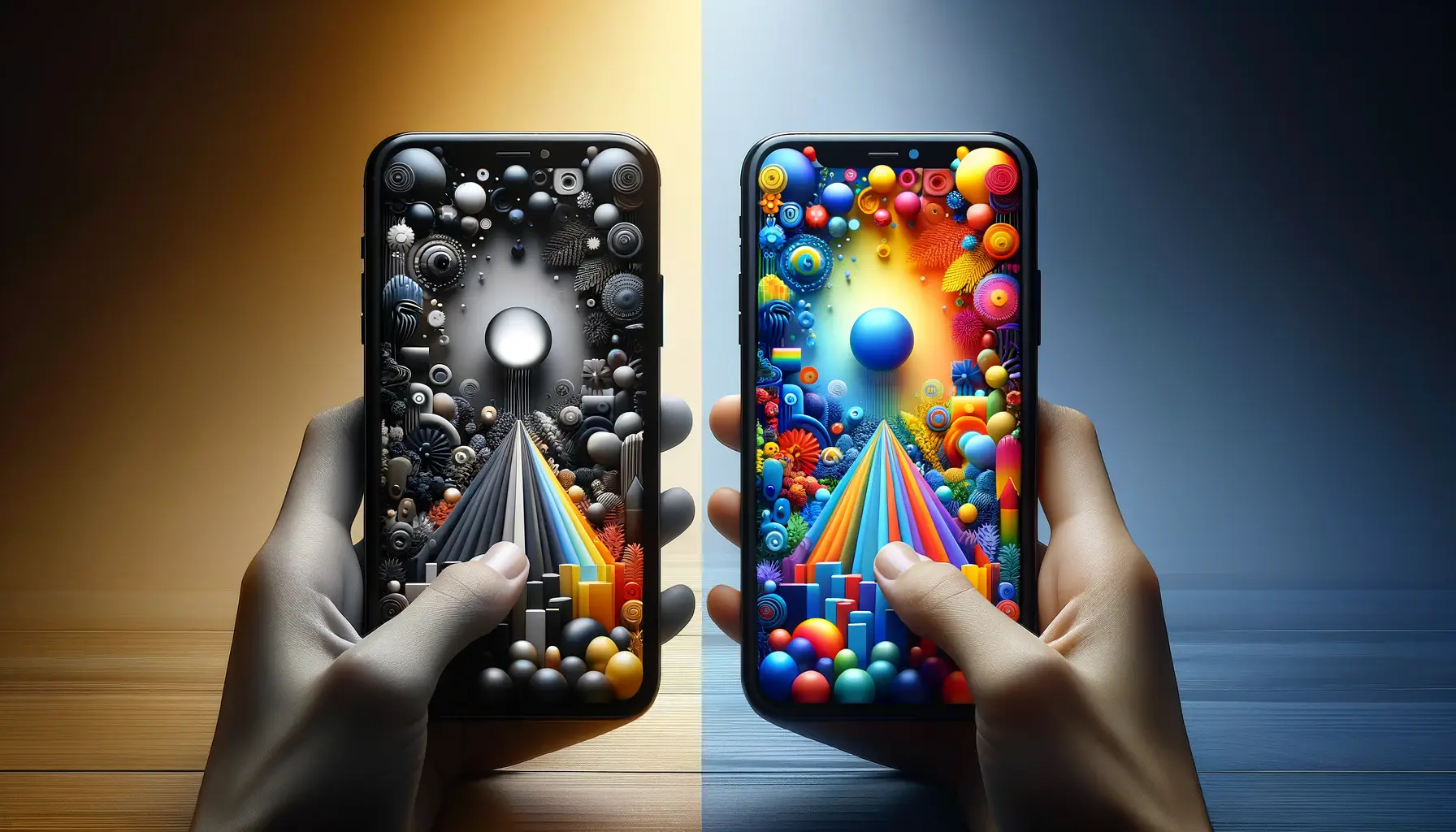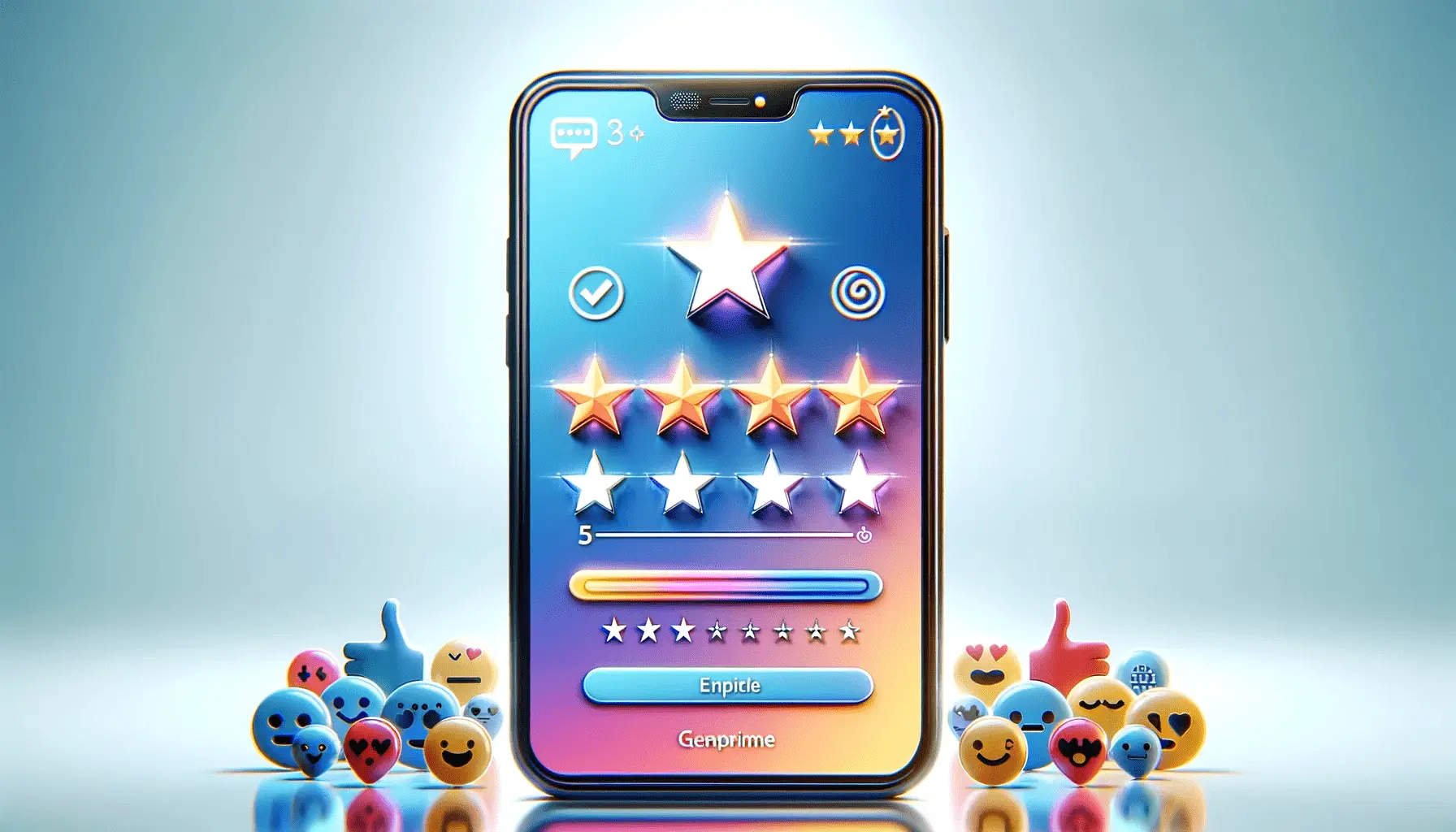The visual elements of an app, especially its icon, play a critical role in its success on various app stores.
An app’s icon is not just a small, artistic image; it encapsulates the essence of the app, serving as the first point of interaction between the app and its potential user.
This interaction can significantly influence the app’s ratings and overall success.
Understanding the connection between icons and ratings is crucial for developers and marketers aiming to improve their App Store Optimization (ASO) strategies.
Icons and ratings are interconnected in a way that goes beyond mere aesthetics.
An effectively designed icon can attract users, making them more likely to download and engage with the app.
This increased engagement often leads to better ratings, as satisfied users are more inclined to leave positive feedback.
Conversely, an unappealing or unclear icon may deter users from downloading the app, negatively affecting its ratings and visibility on the app store.
- The Importance of Icon Design in ASO
- Strategies for Crafting the Perfect App Icon
- Optimizing Icons for Different Platforms
- Incorporating User Feedback into Icon Design
- Impact of Icon Updates on App Performance
- Utilizing Social Media to Enhance Icon Visibility
- Future Trends in Icon Design and ASO
- Conclusion: Navigating the Nexus of Icons and Ratings in App Success
- FAQs on Icons and Ratings
The Importance of Icon Design in ASO
Icon design holds paramount importance in ASO for several reasons.
Firstly, it is the visual representation of the app’s brand and functionality.
A well-designed icon can convey the app’s purpose at a glance, appealing to the right audience and increasing the likelihood of downloads.
The design process should consider factors such as color, simplicity, and uniqueness to create an icon that stands out in the crowded app marketplaces.
Moreover, the icon’s design influences user perception and decision-making.
A professional and appealing icon instills trust in potential users, persuading them to explore the app further.
This initial trust can translate into higher download rates and, subsequently, more positive ratings.
As ratings improve, the app’s visibility in search results and top charts increases, creating a virtuous cycle of visibility and engagement.
Case Studies and Impact
Several case studies highlight the impact of icon design on app ratings and downloads.
For example, a simple change in icon color or design elements can lead to a significant increase in user engagement and ratings.
By conducting A/B testing with different icon designs, developers can gain insights into user preferences and optimize the icon for better performance.
These optimizations can result in improved app visibility, higher download rates, and more positive ratings.
In addition to design elements, the relevance of the icon to the app’s content and target audience is crucial.
An icon that accurately represents the app’s functionality and appeals to the intended demographic can greatly enhance user interest and satisfaction.
This alignment between icon design and app content is key to achieving higher ratings and success on app stores.
An effective icon design is more than just an aesthetic choice; it’s a strategic tool in enhancing app visibility, engagement, and ratings.
Strategies for Crafting the Perfect App Icon
Designing the perfect app icon that resonates with users and enhances app ratings involves a combination of art, science, and marketing.
The strategy encompasses understanding user psychology, market trends, and the technical constraints of app stores.
Below are key strategies to craft an icon that stands out and positively influences app ratings.
Understanding User Psychology
User psychology plays a crucial role in how potential users perceive an app icon.
An icon that evokes positive emotions or curiosity is more likely to be clicked on.
This involves:
- Color Psychology: Utilizing colors that evoke the right emotions and match the app’s theme can significantly impact user engagement. For example, blue can convey trust and dependability, while red can signify energy and passion.
- Imagery and Symbolism: The use of familiar symbols or imagery can make the icon more relatable and understandable at a glance, which is crucial for quick user decision-making.
Competitive Analysis
Conducting a competitive analysis is vital to understanding how your app stands out in the crowded app marketplace.
This includes:
- Identifying common design elements in your app category and determining how to differentiate your icon.
- Studying top-performing apps in your category for insights into design trends and user preferences.
Technical and Design Considerations
The technical and design considerations of an app icon involve several elements that ensure the icon not only looks appealing but also meets app store requirements:
- Simplicity and Clarity: A simple yet impactful design ensures the icon is recognizable even at smaller sizes.
- Scalability: The icon should maintain its integrity and appeal across different device resolutions and sizes.
- Branding Consistency: The icon should align with the app’s branding, including color schemes and imagery, to enhance brand recognition.
Iterative Testing and Optimization
A/B testing and optimization are critical to refining the app icon based on real user feedback and data.
This process involves:
- Creating multiple icon designs and testing them with a segment of your target audience.
- Collecting data on user engagement, click-through rates, and download rates for each icon variant.
- Optimizing the icon based on performance data and continuing to test until the most effective design is identified.
Remember, the goal is to create an icon that not only captures attention but also accurately represents the app, encouraging users to download and positively rate the app.
Optimizing Icons for Different Platforms
Optimizing app icons for different platforms, such as the Apple App Store and Google Play Store, requires a tailored approach due to the distinct characteristics and user expectationsof each platform.
Understanding these nuances and adjusting your icon design accordingly can significantly impact your app’s visibility and user engagement rates.
Apple App Store Icon Optimization
The Apple App Store places a high emphasis on design aesthetics and simplicity, reflecting the brand’s overall design philosophy.
To optimize an app icon for the Apple App Store, consider the following:
- Minimalistic Design: Apple users tend to favor clean, simple designs that convey the app’s purpose at a glance.
- Use of Negative Space: Effectively utilizing negative space can make icons more striking and memorable.
- Bright and Bold Colors: While maintaining simplicity, using bright and bold colors can help your icon stand out against the white background of the App Store.
Google Play Store Icon Optimization
The Google Play Store accommodates a wider variety of design aesthetics but also places importance on clarity and recognizability.
For Google Play Store optimization, consider:
- Adaptive Icons: Google Play uses adaptive icons, allowing for a variety of shapes. Ensuring your icon looks good in different shapes is crucial.
- Engaging Imagery: More detailed and character-driven icons tend to perform well on Google Play, appealing to the diverse Android user base.
- Color and Contrast: High contrast and vibrant colors can help your icon pop in the Google Play interface.
Testing Across Devices
Beyond platform-specific optimizations, it’s important to test how your icon appears across different devices and resolutions.
This includes:
- Checking visibility and appeal on both high and low-resolution screens.
- Ensuring the icon’s design elements are distinguishable on various screen sizes.
- Adjusting the icon design based on feedback and performance on different devices.
Localization Considerations
Localization extends beyond language translation to include visual elements like icons.
Certain colors, symbols, and imagery may carry different connotations in different cultures.
To optimize icons for global markets, consider:
- Cultural Relevance: Adapting icons to reflect cultural preferences and taboos can improve user reception in different regions.
- Visual Language: Some markets may prefer more detailed, illustrative icons, while others favor minimalism.
Optimizing your app icon for different platforms and devices is a dynamic process that requires ongoing testing and refinement to meet evolving user expectations and technological advancements.
Incorporating User Feedback into Icon Design
User feedback is an invaluable resource for refining and optimizing app icons to better meet user expectations and improve app ratings.
Incorporating user feedback into the design process not only enhances the icon’s appeal but also fosters a sense of community and user investment in the app.
Gathering User Feedback
Collecting user feedback can be done through multiple channels, ensuring a broad and diverse range of input.
Methods include:
- User Surveys and Polls: Conduct surveys or polls either within the app or on social media platforms to gather opinions on icon designs.
- App Reviews and Comments: Monitor app store reviews and comments for insights into user perceptions and suggestions regarding the app icon.
- Focus Groups: Engage a small, diverse group of users in discussions about potential icon designs to gain detailed feedback.
Analyzing Feedback for Actionable Insights
Once feedback is collected, the next step is to analyze the data to identify common themes, preferences, and areas for improvement.
This involves:
- Identifying Trends: Look for recurring comments or suggestions that indicate a strong user preference or issue with the current icon.
- Considering Demographic Variances: Analyze feedback based on user demographics to identify if certain designs resonate better with specific user segments.
- Quantitative vs. Qualitative Feedback: Balance statistical data from surveys with qualitative insights from comments and focus groups for a well-rounded understanding.
Implementing Changes Based on Feedback
Acting on user feedback is crucial for demonstrating that you value user input and are committed to providing the best user experience.
Implementation steps include:
- Creating revised icon designs that incorporate the most consistent and impactful feedback.
- Testing the new designs through A/B testing or similar methods to measure performance improvements.
- Rolling out the most successful icon update, accompanied by communication to users about the changes and the role their feedback played in the decision.
Maintaining an Iterative Design Process
Incorporating user feedback into icon design is not a one-time task but an ongoing process of iteration and refinement.
Continually seeking and responding to user input ensures that the app icon remains appealing and relevant over time.
This iterative process contributes to sustained user engagement and positive app ratings.
User feedback is a key component in creating an app icon that resonates with your audience, enhances user satisfaction, and ultimately drives better ratings and success for your app.
Impact of Icon Updates on App Performance
Updating an app’s icon can have a significant impact on its performance, affecting user engagement, download rates, and app store rankings.
A well-timed and effectively designed icon update can revitalize an app’s presence in the market, attracting new users while re-engaging existing ones.
Case Studies: Before and After Icon Update
Several case studies illustrate the positive effects of icon updates on app performance.
For instance, apps that have undergone icon redesigns often see a marked improvement in download rates and user engagement metrics.
These changes can also lead to better visibility in app store search results and featured listings, thanks to improved user ratings and reviews driven by renewed interest.
One notable example involved an app that updated its icon to feature more vibrant colors and a simplified design, leading to a 20% increase in download rates within the first month post-update.
Another case saw an app improve its icon clarity and relevance to its core functionality, resulting in a 15% uptick in user engagement and a significant boost in app store ratings.
Measuring the Impact of Icon Updates
To accurately gauge the impact of an icon update, developers should employ a variety of metrics and analysis tools, including:
- Download Rates: Comparing download rates before and after the icon update can provide clear evidence of its impact on user attraction.
- User Engagement Metrics: Analyzing changes in user engagement levels, such as session length and frequency, offers insights into the update’s effectiveness in improving user experience.
- App Store Rankings and Ratings: Monitoring fluctuations in app store rankings and user ratings post-update can indicate the broader perception of the app’s value and appeal.
Best Practices for Icon Updates
To maximize the benefits of an icon update, developers should follow best practices throughout the process:
- Conduct thorough market research and user feedback analysis to inform the design direction.
- Implement the update as part of a broader app update or marketing campaign to maximize visibility and impact.
- Communicate clearly with users about the change, highlighting the reasons behind the update and how it reflects user feedback or improved app functionality.
An icon update, when executed strategically, can serve as a powerful tool in an app’s ASO strategy, contributing to sustained growth and success in competitive app marketplaces.
The decision to update an app’s icon should be data-driven and user-focused, aiming to enhance the app’s visual appeal and relevance to its target audience, thereby positively influencing its overall performance.
Utilizing Social Media to Enhance Icon Visibility
In the digital age, social media platforms offer a powerful channel for promoting app icons and enhancing overall app visibility.
By leveraging social media effectively, developers and marketers can increase their app’s reach, engage with a broader audience, and ultimately drive higher app ratings and downloads.
Creating Shareable Content
Developing content that is tailored for social media and encourages sharing is crucial for maximizing icon visibility.
This includes:
- Icon Reveals: Creating anticipation and excitement by teasing the app icon design process or revealing new icon updates.
- User-Generated Content: Encouraging users to share their own content related to the app can help spread awareness and foster a sense of community.
- Visual Campaigns: Designing visually appealing campaigns that highlight the icon’s design and its significance to the app’s branding and functionality.
Leveraging Hashtags and Influencers
Utilizing hashtags can greatly increase the visibility of your social media content, making it discoverable to users interested in related topics.
Partnering with influencers who can showcase your app icon and share their experiences with the app can also provide a significant boost in visibility and credibility.
Influencer collaborations should be strategic, aiming to reach your target audience through personalities or brands that align with your app’s values and user demographics.
This targeted approach ensures that the promotion reaches individuals most likely to be interested in your app.
Engaging with the Community
Active engagement on social media can strengthen relationships with existing users and attract new ones.
This involves:
- Responding to comments and messages in a timely and personable manner.
- Hosting live Q&A sessions, polls, or contests that encourage interaction and discussion around the app icon and features.
- Sharing behind-the-scenes content related to icon design and development, providing insights into the creative process.
By creating a vibrant and interactive social media presence, developers can turn their app icon into a recognizable symbol that captures the essence of the app, resonating with current users and attracting new ones.
Social media is not just a promotional tool; it’s a platform for storytelling and community building that can significantly amplify your app’s icon visibility and overall brand presence.
Future Trends in Icon Design and ASO
The landscape of app icon design and App Store Optimization (ASO) is constantly evolving, driven by changes in user preferences, technological advancements, and shifts in the digital marketing environment.
Staying ahead of these trends is crucial for developers and marketers aiming to maintain and enhance their app’s visibility and user engagement.
Emerging Design Trends
Future icon design trends are likely to focus on authenticity, personalization, and technological integration:
- Authenticity: Users are increasingly seeking genuine and original app experiences, prompting a move towards unique, hand-crafted icon designs that reflect the app’s individuality.
- Personalization: Advances in technology may allow for dynamic app icons that can be personalized based on user preferences or external factors, such as location or time of day, enhancing user engagement.
- Technological Integration: With the rise of augmented reality (AR) and virtual reality (VR), app icons could evolve to offer interactive or three-dimensional experiences, providing a glimpse into the app’s content in innovative ways.
ASO Strategies for the Future
ASO strategies will need to adapt to these design trends while also embracing new approaches to visibility and user acquisition:
- Data-Driven Optimization: Leveraging data analytics and machine learning algorithms to refine ASO strategies based on real-time user behavior and market trends.
- Global and Local Strategies: Balancing global ASO efforts with localized strategies that cater to the cultural and linguistic preferences of users in different regions.
- Sustainability and Ethical Considerations: Incorporating sustainability and ethical practices into app development and marketing, aligning with the growing consumer demand for responsible tech companies.
Adapting to Platform Evolutions
As app stores and digital platforms continue to evolve, so too will the rules and algorithms governing app visibility and rankings.
Developers and marketers must stay informed of changes to app store guidelines and adapt their ASO and icon design strategies accordingly to ensure continued app success.
The future of icon design and ASO promises exciting opportunities for innovation and engagement.
By anticipating and adapting to these trends, developers and marketers can create app icons that not only captivate users but also drive sustained app growth and success.
The key to future success in icon design and ASO lies in agility and the willingness to embrace change, leveraging emerging trends to create more engaging, personalized, and effective app experiences.
Conclusion: Navigating the Nexus of Icons and Ratings in App Success
The intricate relationship between app icons and ratings underscores a vital aspect of ASO strategy that can significantly influence an app’s visibility, user engagement, and overall success in the competitive digital marketplace.
Through a careful examination of design strategies, platform optimization techniques, user feedback integration, and emerging trends, it’s clear that the creation and refinement of an app icon is not just an art form but a crucial marketing endeavor.
Key Takeaways for Developers and Marketers
To navigate the nexus of icons and ratings effectively, developers and marketers should consider several key takeaways:
- Icon design profoundly affects user perceptions and decisions, making it essential to focus on creating visually appealing and meaningful icons that resonate with the target audience.
- Optimizing icons for different platforms requires a nuanced understanding of each marketplace’s guidelines and user expectations, emphasizing the need for tailored approaches to maximize app visibility and engagement.
- Incorporating user feedback into icon design not only enhances the icon’s appeal but also fosters a sense of community and loyalty among users, contributing to higher ratings and better app performance.
- Staying abreast of future trends in icon design and ASO strategies is imperative for sustaining app growth and success, highlighting the importance of flexibility and innovation in the ever-evolving app ecosystem.
Embracing the Dynamic Relationship
The dynamic relationship between icons and ratings is a testament to the power of visual communication in the digital age.
As apps continue to proliferate across app stores, the ability to stand out through a distinctive and engaging icon becomes increasingly critical.
By embracing best practices in icon design, actively seeking and implementing user feedback, and anticipating future trends, developers and marketers can leverage icons as a powerful tool to enhance app ratings, visibility, and success.
In conclusion, the connection between icons and ratings is more than just superficial; it’s a strategic element that requires careful consideration and continuous refinement.
By understanding and leveraging this connection, developers and marketers can significantly impact their app’s market presence and performance, ensuring a lasting impression on users and a strong foothold in the digital marketplace.
Boost your mobile app's success with our guaranteed App Store Optimization (ASO) service. Leave it to the experts!
FAQs on Icons and Ratings
Explore commonly asked questions about the connection between app icons and ratings, and how they influence app success.
App icons impact user ratings by influencing first impressions and perceived app quality, leading to higher engagement and satisfaction.
Yes, updating an app icon based on user feedback and design trends can significantly improve its ratings by enhancing user appeal.
An effective app icon is visually appealing, clearly conveys the app’s purpose, and stands out in the app store, attracting users.
App icons should be updated when there’s a significant app update, a shift in user trends, or to refresh the app’s look and feel.
Yes, app icons play a critical role in ASO by affecting visibility in search results and influencing user download decisions.
Conduct A/B testing with different icons, measuring their impact on download rates and user engagement to identify the most effective design.
User feedback provides insights into user preferences, enabling developers to refine icons for better engagement and ratings.
Future trends include the use of augmented reality, personalization, and dynamic icons to engage users in innovative ways.






